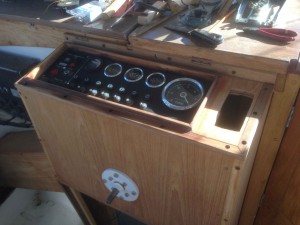V-Berth Rebirth (with strong opinions about drawers on boats)
Clark March 20th, 2017

Like many V-berths, mine was designed to be two bunks, but by putting a board and a cushion between them it becomes a double berth. Since the cushion in the middle is called a keystone cushion by the upholstery people, we’ll call the board the keystone board.
On my boat the keystone board and cushion are in place nearly 100% of the time, creating my captain’s cabin, roughly the size of a queen-sized bed. Below the keystone board is seldom seen, but this is some primo storage, accessed from aft, and visible looking forward from the main cabin. During my circumnavigation it was home to my bike and my guitar. In the photo above it is occupied by a shop vac, and a baby lies on the keystone cushion.
Recently I cleared out the V-berth to replace the opening ports, and upon seeing below the keystone board for the first time in years, decided to gut and rebuild the V-berth.
First, though seldom seen, it’s all unsightly. The teak veneer is peeling off the plywood, and once plywood gets to this point there’s not much to be done for it cosmetically:

Second, below the keystone board, on both sides, are a drawer, a cabinet, and a cubbyhole, none of which are accessible with the board in place and the bed made up:

The cabinets are innocuous, but the cubbyholes are useless, and the drawers are a complete waste of space. I did away with the drawers long ago, keeping only the drawer fronts, fastened from behind:

Drawers are never an efficient use of space on a boat, but of course they’re the best for convenience. A boat should definitely have a few drawers around, especially in the galley, but anyplace you put a drawer you’re giving up some overall space in exchange for that convenience. Drawers are square and boats are round, so a drawer never takes full advantage of the volume it occupies. Then add all the support structure a drawer requires, and you’re probably looking at halving, or worse, the volume of a storage space by subdividing into drawers. In my V-berth, for example, the large, deep compartments under each berth were completely blocked off – interrupted – by the drawers and their supporting structures.
I found while cruising that larger storage spaces, big enough for a sail or an outboard motor, were the hardest to come by. Smaller items can always find a home. By ripping out my drawers I opened up some big new storage spaces, but they could only be accessed from above, meaning moving a mattress and bedding.
Finally, they say with fiberglass boats of certain vintage they built wooden boats inside of fiberglass boats. This was especially true at the foot of my V-berth, the forward part, where they’d built a wooden boat inside a fiberglass boat, then changed their minds and did it a second time inside the first, then threw in some fake bulkheads and terrible access. This was the only entry:

By gutting it and rebuilding it this:

…was replaced by just the two unpainted beams running athwartships, opening about two cubic feet of previously-unused storage space:

So my new design would have no drawers, cabinets, or cubbyholes. The only access to the storage would be from above, from under the bunks, but I’d want plenty of ventilation, so I put in five of these round vents:

Finally, the boards under the bunks didn’t allow for very good top access, since they assumed the whole space would be occupied by the drawers. I made templates and then cut new boards from a sheet of half inch marine plywood. I think it’s a good idea to have lots (6) of smaller boards for access, rather than fewer larger boards, and to divide starboard from port so you can open the bedding like a book and get to one side of the storage. It would be tempting to have the boards at the foot of the bunk (forward) be one piece, but then you’d have to move, or bend up both mattresses:

I made the aft boards the smallest, so I can get to them from a standing position, while lifting up the head of one mattress:

Of course I varnished all the new work and everything else in there. I spray painted all the headliner panels years ago. It was time to do it again:

You’ll notice I didn’t show you the final product with the cushions back in place? That’s because the cushions are also fifty years old, but that’s a project for another day.
